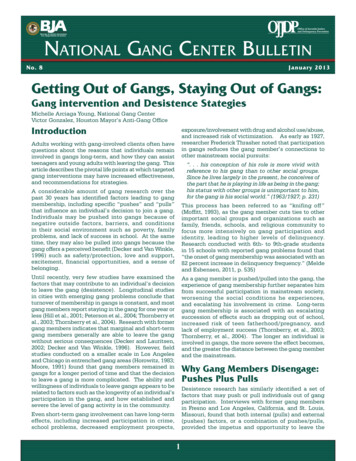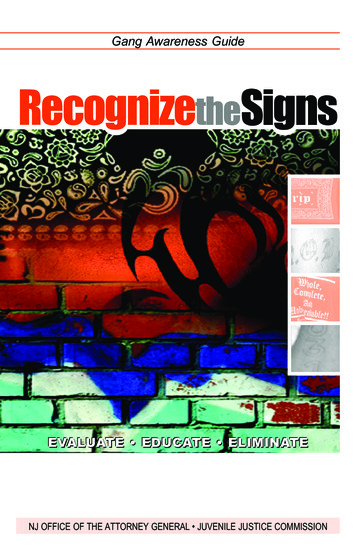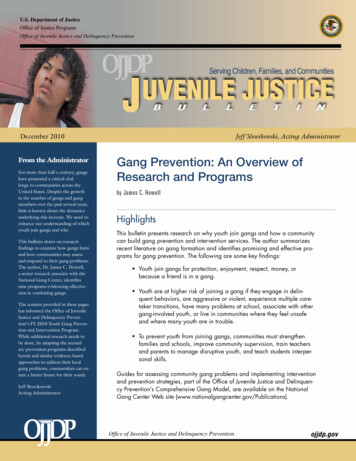
Transcription
Bureau of Justice AssistanceU.S. Department of JusticeNational Gang Center BulletinNo.No. 81January 2013February2007Getting Out of Gangs, Staying Out of Gangs:Gang intervention and Desistence StategiesMichelle Arciaga Young, National Gang CenterVictor Gonzalez, Houston Mayor’s Anti-Gang OfficeIntroductionexposure/involvement with drug and alcohol use/abuse,and increased risk of victimization. As early as 1927,researcher Frederick Thrasher noted that participationin gangs reduces the gang member’s connections toother mainstream social pursuits:Adults working with gang-involved clients often havequestions about the reasons that individuals remaininvolved in gangs long-term, and how they can assistteenagers and young adults with leaving the gang. Thisarticle describes the pivotal life points at which targetedgang interventions may have increased effectiveness,and recommendations for strategies.“. . . his conception of his role is more vivid withreference to his gang than to other social groups.Since he lives largely in the present, he conceives ofthe part that he is playing in life as being in the gang;his status with other groups is unimportant to him,for the gang is his social world.” (1963/1927; p. 231)A considerable amount of gang research over thepast 30 years has identified factors leading to gangmembership, including specific “pushes” and “pulls”that influence an individual’s decision to join a gang.Individuals may be pushed into gangs because ofnegative outside factors, barriers, and conditionsin their social environment such as poverty, familyproblems, and lack of success in school. At the sametime, they may also be pulled into gangs because thegang offers a perceived benefit (Decker and Van Winkle,1996) such as safety/protection, love and support,excitement, financial opportunities, and a sense ofbelonging.This process has been referred to as “knifing off”(Moffitt, 1993), as the gang member cuts ties to otherimportant social groups and organizations such asfamily, friends, schools, and religious community tofocus more intensively on gang participation andidentity, leading to higher levels of delinquency.Research conducted with 6th- to 9th-grade studentsin 15 schools with reported gang problems found that“the onset of gang membership was associated with an82 percent increase in delinquency frequency.” (Meldeand Esbensen, 2011, p. 535)Until recently, very few studies have examined thefactors that may contribute to an individual’s decisionto leave the gang (desistence). Longitudinal studiesin cities with emerging gang problems conclude thatturnover of membership in gangs is constant, and mostgang members report staying in the gang for one year orless (Hill et al., 2001; Peterson et al., 2004; Thornberry etal., 2003; Thornberry et al., 2004). Research with formergang members indicates that marginal and short-termgang members generally are able to leave the gangwithout serious consequences (Decker and Lauritsen,2002; Decker and Van Winkle, 1996). However, fieldstudies conducted on a smaller scale in Los Angelesand Chicago in entrenched gang areas (Horowitz, 1983;Moore, 1991) found that gang members remained ingangs for a longer period of time and that the decisionto leave a gang is more complicated. The ability andwillingness of individuals to leave gangs appears to berelated to factors such as the longevity of an individual’sparticipation in the gang, and how established andsevere the level of gang activity is in the community.As a gang member is pushed/pulled into the gang, theexperience of gang membership further separates himfrom successful participation in mainstream society,worsening the social conditions he experiences,and escalating his involvement in crime. Long-termgang membership is associated with an escalatingsuccession of effects such as dropping out of school,increased risk of teen fatherhood/pregnancy, andlack of employment success (Thornberry, et al., 2003;Thornberry, et al., 2004). The longer an individual isinvolved in gangs, the more severe the effect becomes,and the greater the distance between the gang memberand the mainstream.Why Gang Members Disengage:Pushes Plus PullsDesistence research has similarly identified a set offactors that may push or pull individuals out of gangparticipation. Interviews with former gang membersin Fresno and Los Angeles, California, and St. Louis,Missouri, found that both internal (pulls) and external(pushes) factors, or a combination of pushes/pulls,provided the impetus and opportunity to leave theEven short-term gang involvement can have long-termeffects, including increased participation in crime,school problems, decreased employment prospects,1
gang (Pyrooz and Decker, 2011). Push factors “makepersistence in that social environment unappealing,they are viewed as ‘pushing’ the individual away fromthe gang” (Decker and Pyrooz, 2011, p. 12). Pull factors,alternatively, are “circumstances or situations that attractindividuals to alternative routes toward new activitiesand pathways” (Decker and Pyrooz, 2011, p. 12).factors that appear to influence gang desistence haveimplications for gang intervention programming.Using Gang Desistence Researchto Identify Leverage PointsDesistence research highlights crucial leverage pointsin a gang member’s life that may lead him to reconsiderand end his gang membership. These experiencesinclude involvement with the criminal justice system,negative contacts with law enforcement, victimizationby other gang members, periods of disruption ofthe framework of the gang, and client maturation/life change events such as a romantic relationship,pregnancy, birth of a child, family health issues, etc.(Decker and Lauritsen, 2002). Whether these pointsoccur abruptly or over a period of time, they influencethe client’s view of his own gang membership and itsvalue to him.Most desistence studies note that the effects ofthese pushes and pulls are cumulative. Former gangmembers in Los Angeles noted that maturity, increasedfamily commitments, and peer victimization createda snowballing effect which, in combination, led tothe decision to disengage from the gang (Vigil, 1998).Research with gang members in St. Louis found thatexposure to gang-related violence involving the gangmember, his close friends, and/or family members ledthe individual to renounce ties to the gang (Decker andLauritsen, 2002). Decker and Lauritsen note: “Familialties and victimization experiences were cited farmore often than institutional affiliations as reasons toterminate the ties to the gang.” (2002, p. 58)These leverage points provide an opportunity whenclients who have previously been committed to the ganglifestyle may become more receptive to alternatives:Increased family responsibilities and, in particular,the birth of a child, also may provide an incentive for amajor lifestyle change for gang members: “For manyyoung men, fatherhood acts as a significant turningpoint, facilitating a shift away from gang involvement,crime and drug sales; a decline in substance abuse;and engagement with education and legitimateemployment” (Moloney, et. al., 2009, p. 306).Pushes Grew out of the ganglifestyle Criminal justice systemInvolvement Police harassment orpressure Personal or vicariousvictimizationPulls Familial responsibilities Job responsibilities Significant other Moved Family left the gang Gang fell apart“Many of these gang members, though lackingwork opportunities and experience, aspire to lead a“conventional life,” particularly to obtain legitimateemployment, to have their own place, and tohave a family. They are cognizant of their limitededucational background and lack of technicaltraining, and realize that their future employmentprospects lie in low-paid occupations unlessthey can obtain further education. . .Wherethey may once have been uninterested ordisdainful of various job-opportunity, training,or educational programs, after fatherhood manywere increasingly desirous of such supports,but sometimes found them difficult to access.”(Moloney et al., 2009, p. 318).Using these leverage points to focus gangintervention activities may increase long-termprogrammatic effectiveness.Decker and Lauritsen, 2011Creating a Gang Desistence PlanEach individual who is involved in gangs has atolerance limit for the negative experiences connectedwith his gang membership. When that limit isreached, the negatives of gang membership start tooutweigh the positives (Pyrooz et al., 2010), and otheralternatives become more appealing. Decker and Pyrooznote that:While the majority of desistence research has focusedon gang members’ reasons for leaving the gang,research conducted with 91 gang-involved fathersin San Francisco (Moloney et al., 2009) focused ontheir long-term success at staying out of gang andcriminal involvement. The personal circumstances ofthese research subjects demonstrate the long-termnegative effects of gang affiliation and separation frommainstream pursuits:“. . .many of the people interviewed talked abouthow things eventually built up for them andthey had to find a new lifestyle—that the ganglifestyle and its attendant pressures (arrests, beingstopped by the police, living under the threat ofvictimization) just got to be too much for them.These pressures, coupled with increasing family andjob responsibilities, laid the groundwork for gettingout of gang life.” (2011, p. 13)“Less than half received a high-school diploma, andmore than one-quarter dropped out of school andnever returned. . .Close to half of the fathers hadjobs, although the overall median job income wasrelatively low at U.S. 1,300 per month. Additionalincome among gang fathers came from a varietyof sources, especially drug sales.” (Moloney et al.,2009, p. 310).While the combination of factors that lead to gangdesistence is different for each individual, the overall2
While little research has been conducted on long-termgang desistence strategies, more extensive researchon criminal and substance abuse desistence can helpto inform gang intervention strategies. Best practicesin those areas include removing barriers which maykeep the individual stuck in a life of gangs and crimewhile simultaneously helping the individual to gain andmaintain “new adult roles and responsibilities” andaffirming these steps forward (Hussong et al., 2004).Further, research by Moloney et al. (2009) providesinsights into components of interventions with gangmembers that may increase long-term success withdesistence.attempted to leave the gang have been threatened,assaulted, and even killed. Any adult working withgang members should be aware of the potentialrisks and consequences, both to the gang memberand to his family, and ensure that any advice thatis given takes these risks into consideration. Ganginterventionists also should ensure that they arefamiliar with local gangs, their rivalries, territories,and current activities and conflicts.Clients should be advised not to openly discussleaving the gang with their gang or its leaders, orto participate in departure rituals such as gettingcliqued or jumped out. These approaches canresult in serious harm to the client. In most cases,gradually disconnecting (fading away) from thegang is the best approach. Gang interventionistsalso must be careful not to share informationabout the client’s plan with other gang membersor clients.Gang interventionists can help gang members who areseeking to leave the gang lifestyle by providing themwith accurate advice about transitioning out of gangsand helping them design a plan for leaving the ganglifestyle. This gang desistence plan should identify/remove barriers and replace them with appropriateopportunities to successfully reenter the mainstreamworld.The risks posed to individual gang members varyby community and individual, so interventionistsmust carefully address the following considerationswith each client:Step 1: Remove barriersWithout a high school diploma, and with more streetskills than employment skills, the gang member whodecides to change his life may quickly run into barriersto the noncriminal world. These barriers might includelack of education and/or literacy, lack of employmentskills, lack of documents needed to work, unfamiliaritywith the methods of obtaining employment, unfamiliaritywith the protocols necessary to succeed on the job, andpersonal issues such as anger management issues,family conflict, mental health issues, and involvementin substance abuse. Is the gang member or his family at risk of immediateharm for cutting ties with the gang? Does his gang typically threaten or victimizeindividuals who try to leave?Based on the answers to these questions, theinterventionist should work with the client todevelop a plan for the client’s departure from thegang. This plan should include the following steps: Avoid direct confrontations and makingstatements about leaving the gangInterventionists should help gang-involved clientsidentify and remove barriers that currently keep themfrom leaving the gang and participating in prosocialactivities. These might include the following: Spend less time with the gang/individual gangmembers Focus on court/family/school/work responsibilities Practice refusal skills and excuses Threat of violence from the gang Notify interventionist/law enforcement in theevent of safety concerns“Blood in, blood out” is a common phrase used bystreet gangs to describe the process of enteringand leaving a gang, though it is rarely acted uponin a fatal manner. It can be interpreted as follows:gang members may shed their blood (duringthe initiation) to get into the gang, and they arefrequently told that they have to shed their bloodto get out.Adults can help gang members who are seekingto leave the gang lifestyle by providing them withaccurate advice about transitioning out of gangsand helping them design a plan for leaving thegang.However, most individuals are able to leave theirgangs without the threat of violence. Interviewsconducted by Decker and Pyrooz (2011) with formergang members found that the overwhelmingmajority (91 percent) “just left their gang and didnot have to engage in any exceptional means toquit” (p. 13).Ideally, the client’s desistence plan should limit hisability to spend time with other gang members byincreasing his participation in alternative activities(job/school/spending time with family). It may alsoinclude family or criminal justice sanctions such ascurfews, no-contact probation orders, electronicmonitoring, etc.In the worst cases, though, gang members arethreatened with death if they leave the gang. Inprison gangs, this threat of violence is occasionallycarried out. It also has been acted upon by streetgangs, and in some cases, gang members whoClients also need coaching on making excuses ifthey are directly confronted by the gang, usingfamily members to provide a barrier to gangattempts to reach them, and on how to reach out tointerventionists and/or law enforcement if they are3
directly or indirectly threatened. In some situations,more extreme solutions such as moving or relocationmay be required to protect an individual from gangretaliation or punishmentChanging Self ImageFrank K. joined the JQA when he was 10 years old.He had a poor relationship with his parents, and hisyounger brother eventually joined the gang as well.Frank K. gradually gained stature in the gang. Byage 19, he was given responsibility for recruitmentof new members and for ensuring that all of theschools in the gang’s territory were controlled byJQA members. His younger brother played a similarrole in the gang. In 2011, Frank K. was assaulted byprison gang members in retaliation for a homicidecommitted by JQA, and his home was burglarizedby the prison gang. As a result, Frank K. decidedto decrease his gang involvement to protect himselfand his family. External identification as a gang memberGang symbols, clothing, tattoos, and other visualcues can mark an individual as a gang member,making the transition out of the gang moredifficult and dangerous. Gang attire and tattoospose barriers to educational and employmentopportunities and acceptance in mainstreampursuits, and they also can lead to confrontationswith rivals and enemies.The gang member should be asked to identifyclothes associated with the gang lifestyle and todiscard them. Highly visible gang tattoos alsoshould be identified, hidden, and considered forremoval or masking. The interventionist shouldidentify resources that can provide the gangmember with alternative clothing through the useof vouchers, guided shopping trips, donations fromthrift stores and/or dry cleaners, and corporatesponsors. A shopping trip with coaching by thegang interventionist can provide the client withguidance on work-appropriate clothing choices.Partnering with local medical professionals or tattooremoval facilities to perform free or low-cost tattooremovals also can be helpful.Frank K. met with a gang intervention specialist todiscuss his future goals. While he was confidentabout his leadership skills in his gang, he wasunsure how to be a good father, boyfriend, androle model to his brother. Over a period of months,the interventionist worked with Frank to helphim identify changes he should make, includingremoving gang tattoos, changing his style of dress,and reducing the amount of time he spent withthe gang. Frank K. suffered a few setbacks duringthis process, including being fired for having anargument with another employee. However, theinterventionist continued to encourage Frank K’sbehavioral changes, meeting with him two to threetimes a week to discuss his daily activities andhelping him change his behavior patterns. Priorto each tattoo-removal session, Frank K. also metwith his interventionist to discuss the internal andexternal changes he was making.The interventionist should help the gang memberidentify danger zones where rivals may be present(on the bus, at school, on certain street corners,in certain neighborhoods) and help the individualdevelop an action plan to avoid encountering rivalgang members and/or to respond to an inadvertentconfrontation.The interventionist also assisted Frank withobtaining professional attire and feeling comfortablein normal clothing. Once Frank became comfortablewith these changes, the interventionist took himto an employment center where he received leadsabout two jobs, both offering more money than hewas currently making. The employment counselortold Frank K. that he was given the leads becauseof his professional appearance and because heappeared focused and goal-oriented during theinterview. This positive feedback increased Frank’sself-confidence. He successfully interviewed for oneof the jobs and was hired.Long-term gang members with high-profile streetreputations are likely to experience more difficultieswith disengaging from the gang. The individual’shistory of gang involvement may include long list ofprior hostilities with rival gangs and participation inviolent crimes. As a result, rival gang members areunlikely to stop pursuing their grievances againstthe client simply because he has taken steps todistance himself from his gang. Interventionistsneed to spend time explaining this issue to theclient and working with law enforcement or criminaljustice agencies to assess the individual’s risk ofbeing targeted for retaliation to ensure that themeasures taken to disconnect the individual fromthe gang will be safe. Public transportation, forinstance, may not be a safe option for some gangmembers.Frank K. shared with his intervention counselor thathe felt like a normal person, not a gang member, atthe job interview, and that he feels he is learning tofunction in mainstream society. Frank states thathe will keep making efforts because he wants hisson to see him as a good father, not a gang memberwho passes on the gang lifestyle to his child. Frankrealizes that he has more changes to make and thathe has to be consistent in his new way of life.Even for less-involved gang members, proximityto the gang or neighborhood may keep theindividual tied to gang activity, drug use, and crime.Understanding and addressing the connectionbetween the individual, the gang, rival gangmembers, and the community is crucial to effectiveintervention.4
Internal identification as a gang member1991), 32 percent of the fathers of gang memberswho were interviewed stated that their childrenbelonged to the same gang to which the fathers hadonce belonged, and 11 percent stated that as manyas four generations had belonged to the same gang.Miller (2001) found that 79 percent of the femalegang members she interviewed had at least onefamily member involved in gangs, and 60 percenthad two or more family members involved in gangs.Gang membership provides an individual withan identity linked to aggression and violence.Giordano, Schroeder, and Cernkovich (2007)characterized this self-concept as an “angeridentity” and noted that individuals involved ingangs came to view themselves as having lowlevels of impulse control and a hair-trigger tendencyto resort to violence.In multigenerational gang families, interventionswith gang members who wish to leave the gangcan be extraordinarily difficult, because thefamily may be antagonistic and unsupportivetoward the client’s efforts to change. In suchinstances, residential programs outside the homearea that offer structured educational/vocationalopportunities, like the Job Corps program, may bea helpful alternative.The gang member’s internal identity also mayinclude a script that describes what it means tobe a man/woman, methods of self-protection,the role of the opposite sex, one’s standing in thecommunity, ways to obtain respect, and a view ofsuccess. These scripts are shaped by the processesof gang involvement and even may be survivalmechanisms. However, these internal scripts areoften incompatible with the prosocial changes thatthe client wishes to make. The client’s desistenceplan should identify internal scripts that may pose abarrier between the client and the mainstream, andshould devise strategies to change these scripts.Inter ventionists of ten find that gang membersexperience multiple barriers to leaving the gang. Thedesistence plan should prioritize the most seriousbarriers first, and then work with gang members overtime to systematically address and/or remove thesebarriers. In some rare instances, the danger to a gangmember attempting to leave the gang may be so greatthat the individual is required to relocate outside thelocal area or even to another state. If so, collaborationwith other local agencies, particularly law enforcement,is vital to protect the individual’s safety. Mental health/substance issuesMany gang-involved clients have untreated mentalhealth issues such as post traumatic stress disorder,anger management issues, attention deficitdisorder, oppositional defiant disorder, etc. Insome cases, these clients may cope with untreatedmental health issues by using drugs and/or alcohol.It is important for the gang interventionist to workclosely with the client to identify substance abuse/mental health issues and then support the clientin dealing with these issues. Typically, the ganginterventionist is not a substance abuse treatmentprovider, but interventionists should developrelationships with local providers, learn aboutavailable services, be able to explain the treatmentprocess and services to clients, help the clientaccess services, and “bridge” the client into theseservices by providing transportation and going withthe client to initial meetings to provide support.Step 2: Help the client “gain andmaintain” adult responsibilities Help the client reenvision his personal identityThe development of internal gang-influencedscripts was discussed earlier. To successfully leavethe gang and rejoin the mainstream, the client mustrewrite his internal identity, including methods ofhandling conflict, gender identity, criminal behavior,personal ethics, interpersonal relationships, andsense of personal safety. This is a long-termprocess. Gang interventionists can help the clientidentify his “gang programming” and the ganginfluenced scripts that are incompatible with hisgoals, as well as rethink his programmed “gang”responses to a variety of situations. Dependence on the gang for social supportFor many clients, the gang serves as their primarymechanism of social support. The gang representsfriendship, family, and community. When the clientleaves the gang, this source of love and supportis lost. Gang members in transition often havedifficulties developing new social connections toreplace their former gang associates. Addressingthis barrier will require the interventionist tofacilitate new sources of social support for the client,including working with the family, identifying newpeer groups, and identifying a support network forthe client at school, at work, and in the community.For instance, street-thinking would suggest aviolent response to perceived disrespect or criticismto avoid losing face with violent peers. On thejob, however, the former gang member is going tohave to learn other methods for responding to hisboss and fellow employees if a conflict arises. Tosupport these changes, it may be helpful for theclient to participate in evidence-based therapeuticinterventions such as cognitive behavioral therapyor aggression replacement therapy. These typesof programs address critical thinking errors andinterpersonal skill deficits while providing gangmembers with new tools for handling difficultsituations as they reframe their self-images. Multigenerational Gang FamiliesNumerous studies have documented the existenceof multigenerational gang affiliation in entrenchedgang areas. In one study (Sanchez-Jankowski,5
Ongoing coaching by interventionists is alsohelpful to support these internal changes as theclient redefines his identity as a person, parent,and member of the community. Instead of beingproud of his prowess in fighting, for instance, thegang member can be encouraged to take pride asa breadwinner and provider, good parent, positiverole model, and successful employee, among hisother positive responsibilities.Providing Employment SupportMathis is a 34-year-old OB gang member who hasserved multiple short prison sentences and typicallyreoffended within 2–3 months after release. Duringhis last period of incarceration, he participated ingang intervention activities for about five months.As a result of his participation in these activities, herealized the importance of being involved in the livesof his wife and children. He decided that gaininglegitimate employment was important to avoidreturning to his previous involvement in drug sales. Help the client set and achieve goalsGang clients may be unclear about their personaland professional goals and also may feel trappedby the number of steps they must take in order toreach those goals. Because of the quick pace andfatalistic mentality of the gang lifestyle, gang clientsalso may have difficulty being emotionally engagedin long-term outcomes. A gang interventionist canuse techniques such as motivational interviewingto help a client identify short-, medium-, and longterm goals. Then the interventionist can help theclient break these goals down into manageabletasks and walk the client through the process ofachieving these smaller goals.For instance, a client whose long-term goal is to geta job currently cannot do so because he does nothave a driver’s license. His short-term goal wouldbe to obtain a driver’s license. The interventionistcan help him create a short list of tasks that hemust complete to get his driver’s license: locatehis birth certificate/social security card/proof ofresidency, clear up traffic tickets, and study forhis driver’s test. Successfully completing each ofthese tasks will bring the client closer to meetinghis short-term and long-term goals. Once thesetasks are accomplished and the goal is met, theinterventionist can help the client by mentallyreviewing the process, acknowledging the client’ssuccess and/or missteps, and using the goal-settingand task-identification process to help the clientwith his next goal.After release, Mathis reconnected with his familyfor a few weeks and then a met with a ganginterventionist to discuss employment options.Mathis and his wife had many questions. Mathispreviously had negative experiences working withemployment agencies and felt that they did nothelp him find a job. The intervention specialistreassured Mathis that the intervention agencyprovided regular training to the employment agencyon working with gang members. He also told himabout the program’s successes with other ganginvolved clients.The intervention specialist spent time discussingthe process of working with the employmentagency, and helped Mathis gather identificationdocuments and enroll in the employment agency’scomputerized client database. The interventionspecialist also personally introduced Mathis to anemployment counselor with experience workingwith gang-involved clients. This introduction helpedMathis feel more comfortable with the process.While talking to the employment counselor, Mathisdisclosed that he wanted a job, but that he had noidea what type of work he would like to do. Theemployment counselor discussed several optionswith Mathis, including welding classes, and evenshowed Mathis how he could obtain funding to payfor this training. Shortly after this meeting, Mathisdecided to delay accepting full-time employmentand enrolled in the welding certification program.While in the welding program, Mathis met with hisintervention specialist two to three times a weekto discuss his desistence plan and daily activities.After Mathis completed his welding certification, hedecided to enroll in an advanced welding course toincrease his employability and earnings.Accomplishing short-term goals helps build theclient’s self-confidence, which, in time, c
victimization) just got to be too much for them. These pressures, coupled with increasing family and job responsibilities, laid the groundwork for getting out of gang life." (2011, p. 13) While the combination of factors that lead to gang desistence is different for each individual, the overall factors that appear to influence gang desistence .










